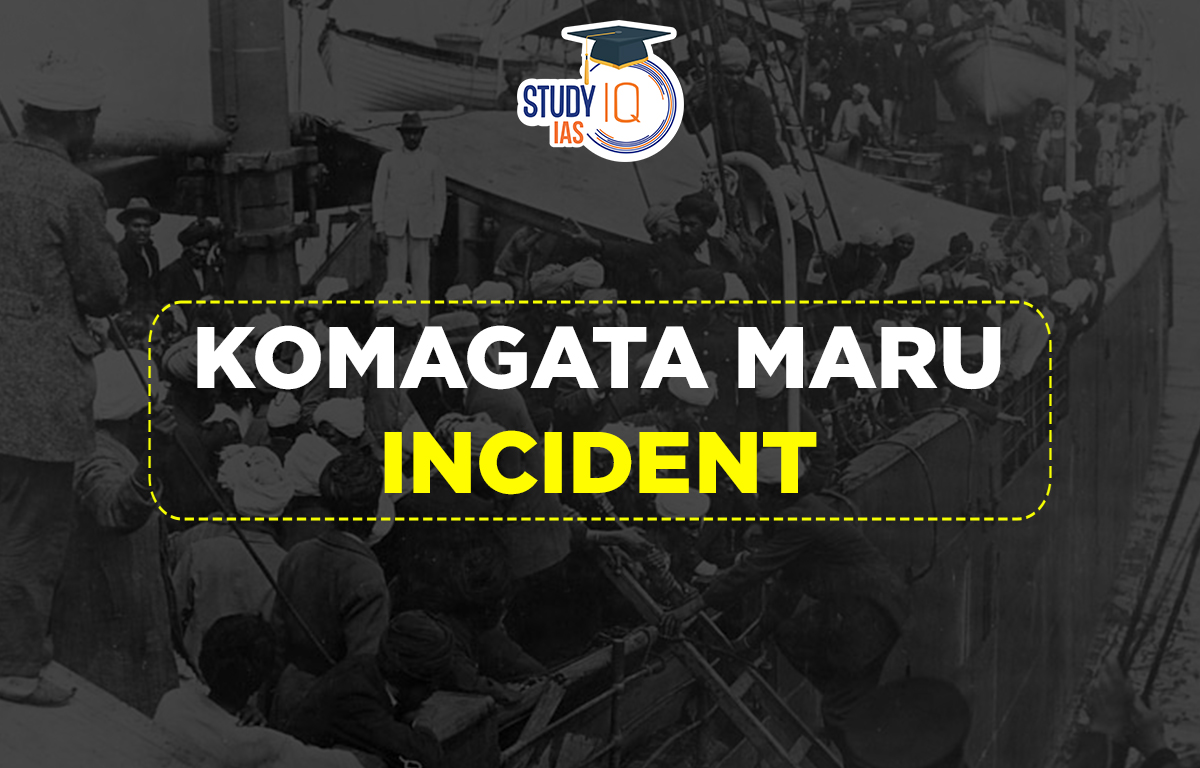Table of Contents
Komagata Maru Incident
In 1914, the Japanese steamship “Komagata Maru” carrying 376 passengers from Punjab, a region of British India, sailed from Hong Kong, a component of the British Empire, to Vancouver, British Columbia in Canada, stopping in Shanghai, China, before continuing to Yokohama, Japan. Because only 24 of the passengers were permitted entry into Canada, the incident attracted notice. The remaining 352 passengers were refused entry, and the ship was forcibly sent back to India.
The significance of this occurrence comes from the explosive situation it sparked in Punjab. The Komagata Maru Incident (1914) will be covered in this article, which will be beneficial for UPSC exam preparation.
Read More: Indian National Movement
What is Komagata Maru?
Komagata Maru was a Japanese steamship that travelled from Hong Kong to Vancouver, Canada in May 1914, travelling via Japan. All 376 of its passengers were refugees from Punjab. When the ship anchored in Vancouver, only 24 of them were permitted to enter Canada. During the period, strict legal restrictions on immigration to Canada applied to people of Asian descent. The ship and its 352 passengers were escorted out of the dock by Canadian military troops and forced to sail back to India following a two-month standoff.
The ship made its way back to Calcutta, where British troops were waiting for it. Guards were put in position for the passengers, and the ship was given permission to dock in Budge, Calcutta. The British believed the passengers to be criminals and political agitators. Attempts by the authorities to apprehend those they believed to be the group’s leaders were met with resistance, and a riot ensued.
| Indian National Movement From 1905-1918 | |
| Indian National Movement |
First World War |
| Partition of Bengal | Swadeshi Movement |
| Muslim League | Morley-Minto Reforms 1909 (Indian Council Act 1909) |
| Ghadar Movement | Komagata Maru Incident |
| Lucknow Pact | Home Rule Movement |
| Surat Split |
Ilbert Bill |
Komagata Maru Incident History
India was not allowed to immigrate to Canada without stringent restrictions. Its rule prohibited entry to anyone besides those who travelled nonstop from India to Canada, or who had “direct passage in their own ship.” The Supreme Court of Canada had permitted admission to 35 Indians who had travelled nonstop in November 1913.
Gurdit Singh, an Indian contractor residing in Singapore, was encouraged by this ruling and made the decision to hire a ship to transport Indians residing in East and Southeast India to Vancouver. Thus, a Japanese ship called the Komagata Maru set sail for Vancouver with 376 Asians aboard (351 Sikhs and 21 Punjabis). Ghadirites visited the ship in Yokohama, Japan, where they delivered lectures and distributed Ghadar literature.
The ship was not permitted to dock in Vancouver after it arrived. In order to defend the rights of the passengers, Hussain Rahim, Sohan Lal Pathak, and Balwant Singh established the “Shore Committee” in Vancouver. Barkatullah, Bhagwan Singh, Ram Chandra, and Sohan Singh Bhakna organised a potent campaign in the USA. However, Komagata Maru was compelled to leave the Canadian seas.
The First World War broke out as the ship was returning, and before it could dock in Yokohama, the British Government issued instructions prohibiting passengers from disembarking anywhere along the route other than Calcutta. The ship arrived in Budge Budge, Kolkata, on September 27th, 1914. When the aggressive behaviour of the police turned into a clash that resulted in the deaths of 18 passengers, the harassed passengers fought. Political machinations broke out in the districts of Jalandhar, Amritsar, and Ludhiana as a result of the pervasive discontent that this caused in Punjab.
Read about: List of Indian National Congress Sessions
Komagata Maru Incident Significance
Indian independence activists were able to reveal the real nature of the British government with the help of human rights abuses like arbitrary detention. The Komagata Maru made several port calls throughout the journey, where political lectures enabled other nations to show their support. Exposure of the Asian Exclusion Act – The leaders only had the ability to question Whiteman’s burden theory because they refused to embrace that “burden” because of the discriminatory immigration laws for Asians. The event served as a recruiting tool for the Ghadar Party‘s massive uprising against the British Empire.
Read about: Anushilan Samiti
Komagata Maru Incident UPSC
The Komagata Maru incident is an important landmark in the history of India, as it catalysed the up surging stage of the Nationalist struggle, by igniting the masses and providing them with a plank to carry out attacks against the Britishers. Read all about Komagata Maru in this article for UPSC Exam Preparations.


 Jallianwala Bagh Massacre, Date, History...
Jallianwala Bagh Massacre, Date, History...
 Important Lakes of India, State wise and...
Important Lakes of India, State wise and...
 Buddhism History, Origin, Sect, Councils...
Buddhism History, Origin, Sect, Councils...





















